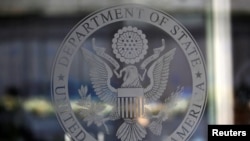ນັ້ນເປັນນຶ່ງໃນການແກ້ໄຂທີ່ສຳຄັນຂອງເອກະສານຄວາມເປັນຈິງທາງອອນລາຍ ຂອງກະຊວງການຕ່າງປະເທດສະຫະລັດ ກ່ຽວກັບ ຈີນ ຊຶ່ງຕັດຊື່ຢ່າງເປັນທາງການຂອງປະເທດຄື ສາທາລະນະລັດ ປະຊາຊົນຈີນ ຫຼື PRC ອອກ ແລະເຫຼືອແຕ່ ຈີນ ເທົ່ານັ້ນ.
ລັດຖະບານຂອງອະດີດປະທານາທິບໍດີ ທ່ານ ໂຈ ໄບເດັນ ມັກອ້າງເຖິງລັດຖະບານປັກກິ່ງດ້ວຍຄໍາຫຍໍ້ວ່າ PRC ນັບຕັ້ງແຕ່ອະດີດ ປະທານາທິບໍດີ
ຣິເຈີດ ນິກສັນ (Richard Nixon) ເລີ້ມຂັ້ນຕອນຟື້ນຟູຄວາມສຳພັນປົກກະຕິກັບປັກກິ່ງ ຊຶ່ງເຮັດໃຫ້ການຮັບຮອງລັດຖະບານໃນ ໄທເປ ທີ່ຮ້ອງຢ່າງເປັນທາງການວ່າ ສາທາລະນະລັດຈີນນັ້ນ ສີ້ນສຸດລົງ, ສະຫະລັດ ໄດ້ຮັກສາຄວາມສຳພັນທາງການທູດກັບລັດຖະບານຄອມມູນິສໃນຈີນແຜ່ນດິນໃຫຍ່ ຂະນະທີ່ຫຼຸດຄວາມສຳພັນກັບ ໄຕ້ຫວັນ ໃຫ້ເຫຼືອພຽງຄວາມສຳພັນບໍ່ເປັນທາງການ ແຕ່ເປັນພັນທະມິດກັນ.
ທ່ານ ຣັສເຊລ ຊຽວ (Russell Hsiao) ຜູ້ອຳນວຍການບໍລິຫານສະຖາບັນລະດັບໂລກຂອງໄຕ້ຫວັນ ກ່າວຕໍ່ອົງການຂ່າວ ວີໂອເອ ວ່າ “ໄທເປ ຄວນເຂົ້າໃຈເອງດ້ວຍຄວາມຈິງທີ່ວ່າ ການປ່ຽແປງຄຳສັບຈາກ PRC ເປັນ ຈີນ ບໍ່ໄດ້ໝາຍເຖິງການປ່ຽນແປງນະໂຍບາຍຂອງ ສະຫະລັດ, ຄວາມຈິງກໍ່ຄື ສະຫະລັດ ຍັງຄົງມີ “ນະໂຍບາຍຈີນດຽວ” ແລະ ພາຍໃຕ້ນະໂຍບາຍນັ້ນ ສະຫະລັດ ຍັງຄົງຮັກສາຄວາມສຳພັນທາງການທູດກັບ ປັກກິ່ງ ແລະຄວາມສຳພັນທີ່ບໍ່ເປັນທາງການຢ່າງໝັ້ນຄົງກັບ ໄທເປ.
ທ່ານ ຊຽວ ກ່າວຕື່ມວ່າ “ນັບຕັ້ງແຕ່ປີ 1979, ວໍຊິງຕັນ ຍອມຮັບລັດຖະບານປັກກິ່ງຂອງ ສາທາລະນະລັດ ປະຊາຊົນຈີນ ວ່າເປັນລັດຖະບານຈີນດຽວ, ດັ່ງນັ້ນ ການປ່ຽນແປງໃນງາລະນີ້ ຈຶ່ງເປັນການນໍາສະເໜີຄວາມເປັນຈິງອັນດຽວກັນ ທີ່ແຕກຕ່າງກັນອອກໄປ, ຊຶ່ງທັງໝົດນີ້ຍັງຄົງບໍ່ມີການປ່ຽນແປງ.”
ຈີນຖືວ່າ ໄຕ້ຫວັນ ເປັນແຂວງນອກກົດໝາຍກອງກຳລັງຊາດນິຍົມ ທີ່ໄດ້ຮັບການສະໜັບສະໜູນຈາກ ສະຫະລັດ, ແລະ ຢູ່ພາຍໃຕ້ການບັງຄັບບັນຊາການຂອງ ທ່ານ ຈຽງ ໄຄ-ເຊັກ ທີ່ໄດ້ລົບໜີອອກຈາກແຜ່ນດິນໃຫຍ່ໄປຍັງ ໄຕ້ຫວັນ ໃຊຸມນປີ 1949 ຫຼັງຈາກທີ່ຜ່າຍແພ້ສົງຄາມກາງເມືອງໃຫ້ກັບກອງກຳລັງຄອມມູນິສ ທີ່ນໍາໂດຍ ທ່ານ ເໝົາ ເຈິີຕຸງ. ທ່ານ ຈຽງ ໄດ້ກາຍເປັນຜະເດັດການທີ່ມີລັກສະນະໃຈດີຂອງໄຕ້ຫວັນ ຈົນຮອດຍາມທີ່ທ່ານເສຍຊີວິດໃນຊຸມປີິ 1975. ທ່ານ ເໝົາ ເຈິຕຸງ, ປົກຄອງແຜ່ນດິນໃຫຍ່ໃນຖານະຜະເດັດການທີເຂັ້ມງວດຈົນຮອດເວລາທີ່ທ່ານເສຍຊີວິດ ພຽງນຶ່ງປີຕໍ່ຈາກ ທ່ານ ຈຽງ.
ວໍຊິງຕັນ ຍັງຄົງຈັດຫາອາວຸດໃຫ້ ໄທເປ, ແລະ ຍັງຄົງຖືກຕັ້ງຄຳຖາມວ່າ ສະຫະລັດ ຈະໃຊ້ກອງກຳລັງທະຫານ ໃນການປົກປ້ອງເກາະແຫ່ງນີ້ຫຼືບໍ່ ຖ້າ ໄຕ້ຫວັນ ຖືກໂຈມຕີ, ກົດໝາຍວ່າດ້ວຍຄວາມສຳພັນ ໄຕ້ຫວັນ ກຳນົດໃຫ້ ສະຫະລັດ ຕ້ອງຊ່ວຍ ໄຕ້ຫວັນ ປົກປ້ອງຕົນເອງ, ແຕ່ການຕັດສິນໃຈຂັ້ນສຸດທ້າຍກ່ຽວກັບການແຊກແຊງທາງທະຫານ ຈະຢູ່ທີ່ປະທານາທິບໍດີ ແລະ ລັດຖະສະພາ.
ອ່ານຂ່າວເປັນພາສາອັງກິດ
That is among the significant modifications to the U.S. State Department’s online fact sheet on China, which drops the country’s official name, the People’s Republic of China (PRC), in favor of just China. [[ https://www.state.gov/u-s-relations-with-china/ ]]
Former President Joe Biden’s administration routinely referenced the Beijing government with the PRC abbreviation. Since former President Richard Nixon began the process to normalize relations with Beijing — which would end recognition of the government in Taipei, officially known as the Republic of China — the United States has maintained diplomatic ties with the communist-run government on the mainland, while reducing the relationship with Taiwan to unofficial but friendly.
“Taipei should take solace in the fact that the change in the term [from PRC to China] does not represent a policy change in the United States. The fact of the matter is that the U.S. still has its ‘One-China Policy,’ and under that policy, it maintains diplomatic relations with Beijing and robust unofficial relations with Taipei,” Russell Hsiao, Global Taiwan Institute executive director, told VOA.
“Since 1979, Washington has recognized the government in Beijing of the People’s Republic of China as the sole legal government of China, so the change in term is essentially a different way of presenting the same set of facts, all of which haven't changed,” Hsiao said.
China considers Taiwan a rogue province. Nationalist forces, backed by the United States and commanded by Chiang Kai-shek, fled the mainland for Taiwan in 1949 after losing a civil war to the communist forces led by Mao Zedong. Chiang became Taiwan’s relatively benign dictator until his death in 1975. Mao ruled over the mainland as a rigid authoritarian until his death a year after Chiang died.
Washington continues to provide Taipei with weapons and has left the question ambiguous as to whether the United States would use its military to defend the island if Taiwan were to be attacked. The Taiwan Relations Act commits the United States to help Taiwan defend itself, but the final decision on military intervention would rest with the president and Congress.






ຟໍຣັມສະແດງຄວາມຄິດເຫັນ